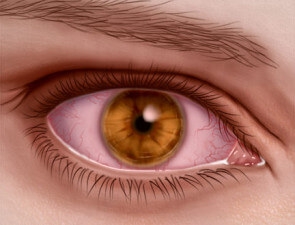Experts consider allergic keratitis as a local manifestation of an allergic reaction in a patient to an external or internal stimulus. In this case, inflammation of the cornea of \u200b\u200bthe eye occurs with very painful symptoms, forcing the patient to immediately consult a doctor. It is very important to try to identify the cause of the development of allergic inflammation, since the elimination of the allergen will greatly speed up recovery. In any case, immediate treatment is prescribed, since the disease threatens with severe complications with loss of vision.
What is allergic keratitis and how to distinguish it
Classification of keratitis is important in order to correctly assess the degree of damage to the eye and prescribe adequate treatment. Traditionally, allergic keratitis is considered in terms of its origin – endogenous or exogenous.
External, exogenous causes that provoke the development of allergic keratosis can be:
- drugs, vaccines;
- food products, spices;
- animal hair, plant pollen;
- cosmetics, perfumery;
- household chemicals, soap and other hygiene products.
Endogenous causes of allergic keratitis are bacterial infections, helminthic invasions, and sometimes tuberculosis intoxication. Bacteria and worms secrete their toxic waste products, which penetrate into the tear fluid and accumulate in it, causing damage to the eyes.
Allergic keratitis can occur against the background of exacerbations of atopic dermatitis, hay fever, bronchial asthma and other allergic diseases.
Among other classifications of allergic keratitis, its division according to etiology is taken into account – bacterial viral, fungal, toxic; according to the depth of the cornea lesion – superficial (with damage to the epithelium) and deep (when the stroma, the membrane of the cornea of the eye, is damaged). In addition, there are central and peripheral keratitis, local and diffuse.
The main signs indicating allergic keratitis
Allergic keratitis is characterized by corneal edema and subepithelial infiltration. Infiltrates can be single and multiple, of different shapes and sizes, depths and localizations. Where an infiltrate is formed, the cornea loses its luster. If the infiltrate is superficial and affects only the epithelium, then it resolves without consequences. If the deep layers of the cornea are affected, then scars can form at the site of inflammation and corneal opacities remain. In addition, allergic keratitis is manifested by vasodilation, ulcers and erosions on the corneal tissue.
 Clinically, the disease is manifested by redness of the eyes, photophobia, blepharospasm, and profuse lacrimation. Patients complain of severe pain in the eyes, burning sensation, sensation of a foreign body in the eye. Sometimes the eyes hurt so much that the patient cannot open them.
Clinically, the disease is manifested by redness of the eyes, photophobia, blepharospasm, and profuse lacrimation. Patients complain of severe pain in the eyes, burning sensation, sensation of a foreign body in the eye. Sometimes the eyes hurt so much that the patient cannot open them.
The danger of developing allergic keratitis without adequate therapy is that the development of clouding in the optical zone of the eye leads to a decrease in vision, which may no longer be restored. In addition, an inflammatory reaction with spread and prolonged course can cause corneal perforation, lead to secondary glaucoma or complicated cataract, endophthalmitis.
Principles of possible treatment of allergic keratitis
It is very important to start treatment by identifying and eliminating the allergen that caused the development of keratitis. Stopping contact with him often leads to a quick recovery. If this fails, then in parallel with the search for the source of inflammation, antibodies are neutralized, the allergic reactivity of the body is reduced and its defenses are increased, metabolic processes and blood vessel permeability are normalized.
Allergic keratitis is usually treated with dexamethasone injections, corticosteroid ointments, in severe cases steroid injections into the conjunctiva and prescribing medications inside. Usually, treatment is carried out in short courses with a gradual decrease in dosages. In parallel, antihistamines, sedatives, vitamins are prescribed, if necessary and according to indications – antibiotic therapy.
Early treatment of allergic keratitis is very important, since the development of the inflammatory process can lead to a significant decrease in visual acuity or even its complete loss.







Add a comment